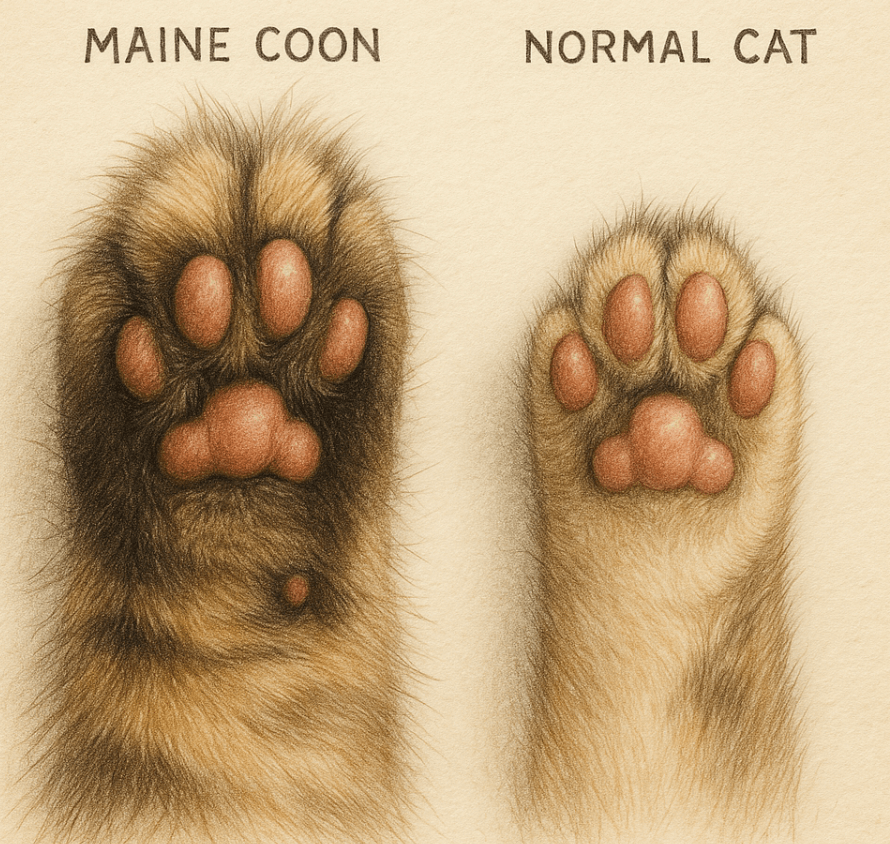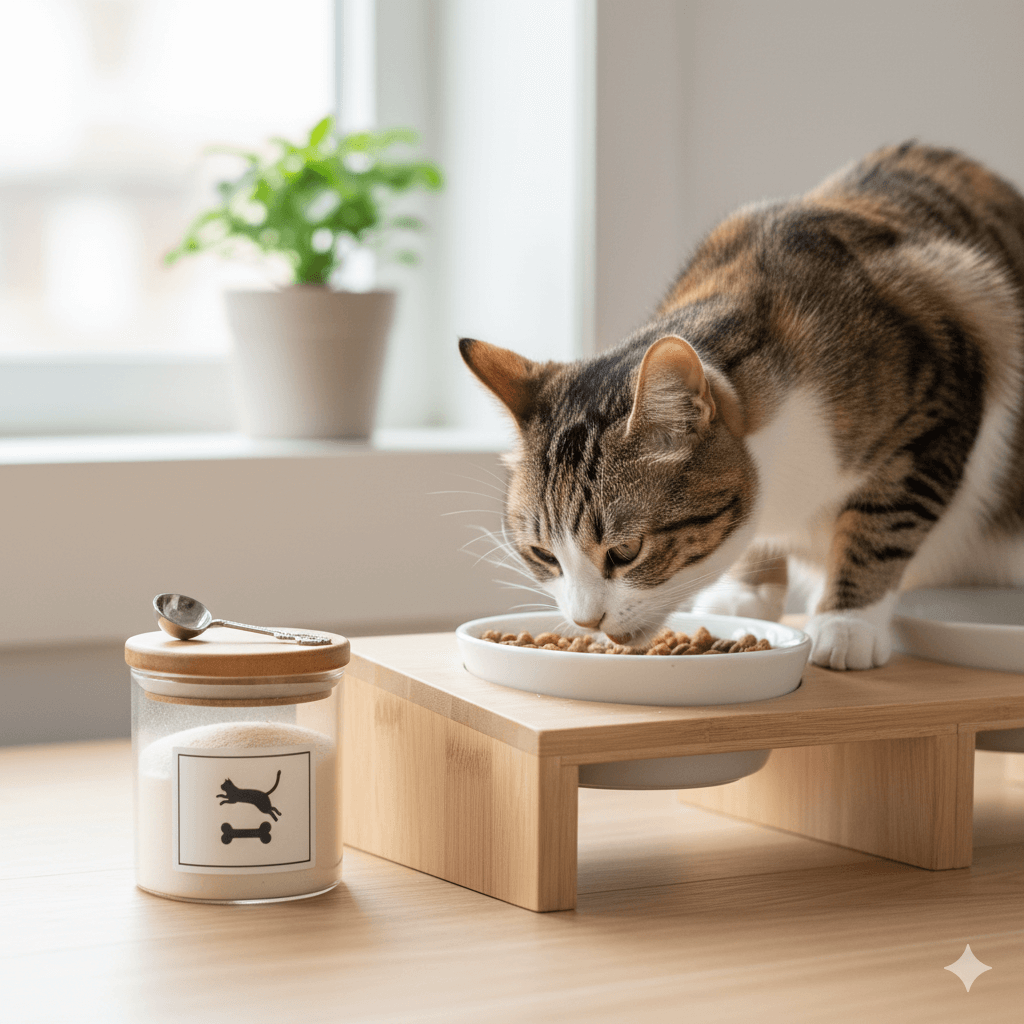Maine Coon Paw vs Normal Cat Paw: What’s the Difference?
The Maine Coon, often referred to as the “gentle giant” of the cat world, is known for its impressive size, luxurious fur, and unique physical traits. Among these distinguishing features, their paws stand out as particularly fascinating. Compared to the average domestic cat, Maine Coon paws are larger, more robust, and serve specific functions that align with their majestic stature.
Whether you’re a proud Maine Coon owner or simply curious about this remarkable breed, understanding the differences between a Maine Coon paw and a normal cat paw can deepen your appreciation for these feline wonders. In this blog post, we’ll explore everything you need to know about Maine Coon paws, from their anatomy to their practical advantages.
Key Differences Between Maine Coon Paws and Normal Cat Paws
Maine Coon paws are uniquely adapted to support their large frames and active lifestyles. Here’s how they differ from the paws of an average domestic cat.
Size and Proportion:
Maine Coon paws are significantly larger than those of most cats, perfectly proportioned to their oversized bodies.Tuition-Like Fur on Paws:
Their paws often have tufts of fur between the pads, providing insulation in cold climates—a trait not commonly seen in smaller breeds.Extra Padding:
The paw pads of a Maine Coon are thicker and more cushioned, offering better shock absorption during high jumps or rough play.Shape and Structure:
Maine Coon paws tend to be more rounded and slightly wider, giving them greater stability and balance.Functional Adaptations:
These paws are designed for walking on snow and uneven terrain, reflecting their origins as outdoor working cats in harsh environments.
These differences highlight the remarkable evolution of Maine Coon paws, making them perfectly suited to their environment and lifestyle.
Unique Features of Maine Coon Paws
Beyond their size and functionality, Maine Coon paws possess several distinctive characteristics that set them apart from other breeds. These features contribute to their charm and utility.
Snowshoe-Like Design:
The large surface area of their paws acts like natural snowshoes, helping them walk on snow without sinking.Enhanced Grip:
Their textured paw pads provide superior traction, allowing them to navigate slippery surfaces with ease.Temperature Regulation:
The fur between their toes helps insulate against cold temperatures, keeping their paws warm in winter.Strength and Durability:
Built to withstand heavy use, Maine Coon paws are sturdy enough to support their weight during vigorous activities.Sensory Abilities:
Like all cats, their paws are highly sensitive, but Maine Coons seem particularly adept at detecting vibrations and textures.
These unique features make Maine Coon paws not only functional but also a testament to their adaptability and resilience.
Check this guide 👉Maine Coon Sphynx Mix: Best 7 Expert Tips!
Check this guide 👉Flame Point Maine Coon Mix: Best 7 Expert Tips!
Check this guide 👉Maine Coon vs Bobcat: Best 7 Expert Tips!

Maine Coon Paw Characteristics | Normal Cat Paw Characteristics |
|---|---|
Larger and rounder shape | Smaller and more compact size |
Tufted fur between toes | Minimal or no fur between toes |
Thick, padded paw pads | Thinner and less cushioned pads |
Snowshoe-like design for snowy terrain | Standard design for indoor/outdoor use |
Enhanced grip and traction | Basic grip suitable for flat surfaces |
Caring for Maine Coon Paws
Proper paw care is essential for maintaining the health and comfort of your Maine Coon. Their unique paws require special attention to ensure they remain in top condition.
Regular Cleaning:
Gently clean their paws with a damp cloth to remove dirt, debris, and any trapped snow or ice.Trimming Fur Between Toes:
Keep the tufts of fur between their toes trimmed to prevent matting and discomfort.Checking for Injuries:
Inspect their paw pads regularly for cuts, cracks, or signs of infection, especially after outdoor adventures.Moisturizing Paw Pads:
Use pet-safe moisturizers to prevent dryness or cracking, particularly in colder months.Nail Trimming:
Trim their nails regularly to avoid overgrowth, which can cause discomfort or injury.
By following these care tips, you can keep your Maine Coon’s paws healthy and functional.
How Maine Coon Paws Enhance Their Lifestyle
Maine Coon paws play a crucial role in supporting their active and adventurous nature. These adaptations make them well-suited for various activities and environments.
Outdoor Exploration:
Their large, padded paws allow them to roam confidently over diverse terrains, including snow and rocky surfaces.Hunting Instincts:
Enhanced grip and sensory abilities make them effective hunters, even in challenging conditions.Jumping and Climbing:
The strength and cushioning of their paws enable them to leap great heights and land safely.Cold Weather Tolerance:
Insulating fur and thick pads help them endure freezing temperatures, a nod to their northern heritage.Playful Agility:
Their stable footing and durable paws support energetic play sessions, whether indoors or outdoors.
These advantages demonstrate how Maine Coon paws are perfectly tailored to their dynamic lifestyle.
Common Misconceptions About Maine Coon Paws
Despite their popularity, several misconceptions surround Maine Coon paws. Clarifying these myths helps owners better understand and care for their pets.
Myth: Large paws mean they’re clumsy.
In reality, their paws enhance stability and agility, making them surprisingly graceful.Myth: They don’t need extra grooming.
The fur between their toes requires regular maintenance to prevent matting and irritation.Myth: Their paws are indestructible.
While durable, they’re still susceptible to injuries and need regular check-ups.Myth: Only outdoor Maine Coons benefit from their paw design.
Even indoor cats enjoy the advantages of their sturdy, versatile paws.Myth: All Maine Coons have identical paws.
Paw size and fur density can vary among individuals, influenced by genetics and environment.
Dispelling these myths ensures a deeper appreciation for Maine Coon paws.
Comparing Maine Coon Paws Across Seasons
Maine Coon paws adapt remarkably well to different seasons, showcasing their versatility. Here’s how they perform in varying weather conditions.
Winter Adaptations:
Their tufted fur and thick pads provide insulation, protecting them from frostbite and icy surfaces.Summer Comfort:
Despite their fur, their paws stay cool thanks to efficient temperature regulation mechanisms.Rainy Weather:
The textured pads offer excellent grip on wet surfaces, reducing the risk of slipping.Dry Conditions:
Regular moisturizing helps combat dryness caused by arid climates or indoor heating.All-Season Durability:
Regardless of the season, their paws remain resilient and functional, supporting their active lifestyle year-round.
Understanding these seasonal adaptations highlights the versatility of Maine Coon paws.
Fun Facts About Maine Coon Paws
Maine Coon paws are not only functional but also full of fascinating quirks. Here are some fun facts that showcase their uniqueness.
“Polydactyl” Paws Are Common:
Some Maine Coons are born with extra toes, a genetic trait known as polydactyly, enhancing their snowshoe effect.Paw Prints Reveal Personality:
Just like human fingerprints, each Maine Coon’s paw prints are unique to them.Sensitive Whiskers Above Paws:
The carpal whiskers above their paws help detect changes in their surroundings, aiding navigation.Natural Shock Absorbers:
Their thick pads act as built-in shock absorbers, protecting joints during high-impact activities.Symbol of Strength:
Their paws symbolize their rugged heritage as hardworking farm cats in New England.
These fun facts add to the charm and mystique of Maine Coon paws, making them even more endearing.
Frequently Asked Questions About Maine Coon Paws
Why are Maine Coon paws so big?
Their large paws are proportionate to their body size and help distribute weight evenly, especially in snowy conditions.
Do Maine Coons need special paw care?
Yes, regular cleaning, trimming, and moisturizing are recommended to maintain their paw health.
What’s the purpose of fur between their toes?
The tufted fur provides insulation and prevents snow from sticking to their paws.
Are Maine Coon paws more prone to injuries?
Not necessarily, but their active nature means owners should monitor their paws for wear and tear.
Can Maine Coons handle rough terrain better than other cats?
Yes, their sturdy paws and enhanced grip make them more adept at navigating uneven surfaces.
Celebrating the Marvel of Maine Coon Paws
The Maine Coon’s paws are a testament to their incredible adaptability and evolutionary prowess. From their snowshoe-like design to their thick, padded structure, every aspect of their paws serves a purpose that enhances their quality of life. By understanding and appreciating these unique features, you can provide the best possible care for your gentle giant. Whether they’re bounding through snow or lounging on your couch, their paws are a vital part of what makes Maine Coons such extraordinary companions.
Understanding Bone Supplement for Cats: Best 7 Expert Tips! – Safe, vet-approved guidance for strong feline bones & balanced nutrition.
Bone Supplement for Dogs: Best 7 Expert Tips! – Expert guide to calcium, collagen & bone health for every life stage.
Understanding Can Cats Get Sunburn: Best 7 Expert Tips! – Protect your feline from UV damage with vet-backed prevention strategies.
How to Train a Seizure Alert Dog: Best 7 Expert Tips! – Learn expert-backed steps to nurture natural instincts into reliable, life-saving seizure alerts.




